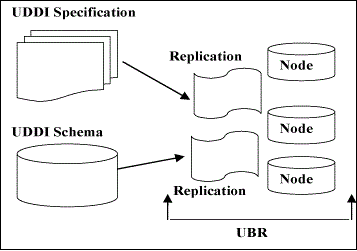
- UDDI Tutorial
- UDDI - Home
- UDDI - Overview
- UDDI - Elements
- UDDI - Technical Architecture
- UDDI - Data Model
- UDDI - Interfaces
- UDDI - Usage Example
- UDDI with WSDL
- UDDI - Implementations
- UDDI - Specifications
- UDDI - Summary
- UDDI API References
- UDDI - API Quick References
- UDDI Useful Resources
- UDDI - Quick Guide
- UDDI - Useful Resources
- UDDI - Discussion
UDDI - Technical Architecture
The UDDI technical architecture consists of three parts −
UDDI Data Model
UDDI Data Model is an XML Schema for describing businesses and web services. The data model is described in detail in the "UDDI Data Model" chapter.
UDDI API Specification
It is a specification of API for searching and publishing UDDI data.
UDDI Cloud Services
These are operator sites that provide implementations of the UDDI specification and synchronize all data on a scheduled basis.

The UDDI Business Registry (UBR), also known as the Public Cloud, is a conceptually single system built from multiple nodes having their data synchronized through replication.
The current cloud services provide a logically centralized, but physically distributed, directory. It means the data submitted to one root node will automatically be replicated across all the other root nodes. Currently, data replication occurs every 24 hours.
UDDI cloud services are currently provided by Microsoft and IBM. Ariba had originally planned to offer an operator as well, but has since backed away from the commitment. Additional operators from other companies, including Hewlett-Packard, are planned for the near future.
It is also possible to set up private UDDI registries. For example, a large company may set up its own private UDDI registry for registering all internal web services. As these registries are not automatically synchronized with the root UDDI nodes, they are not considered as a part of the UDDI cloud.